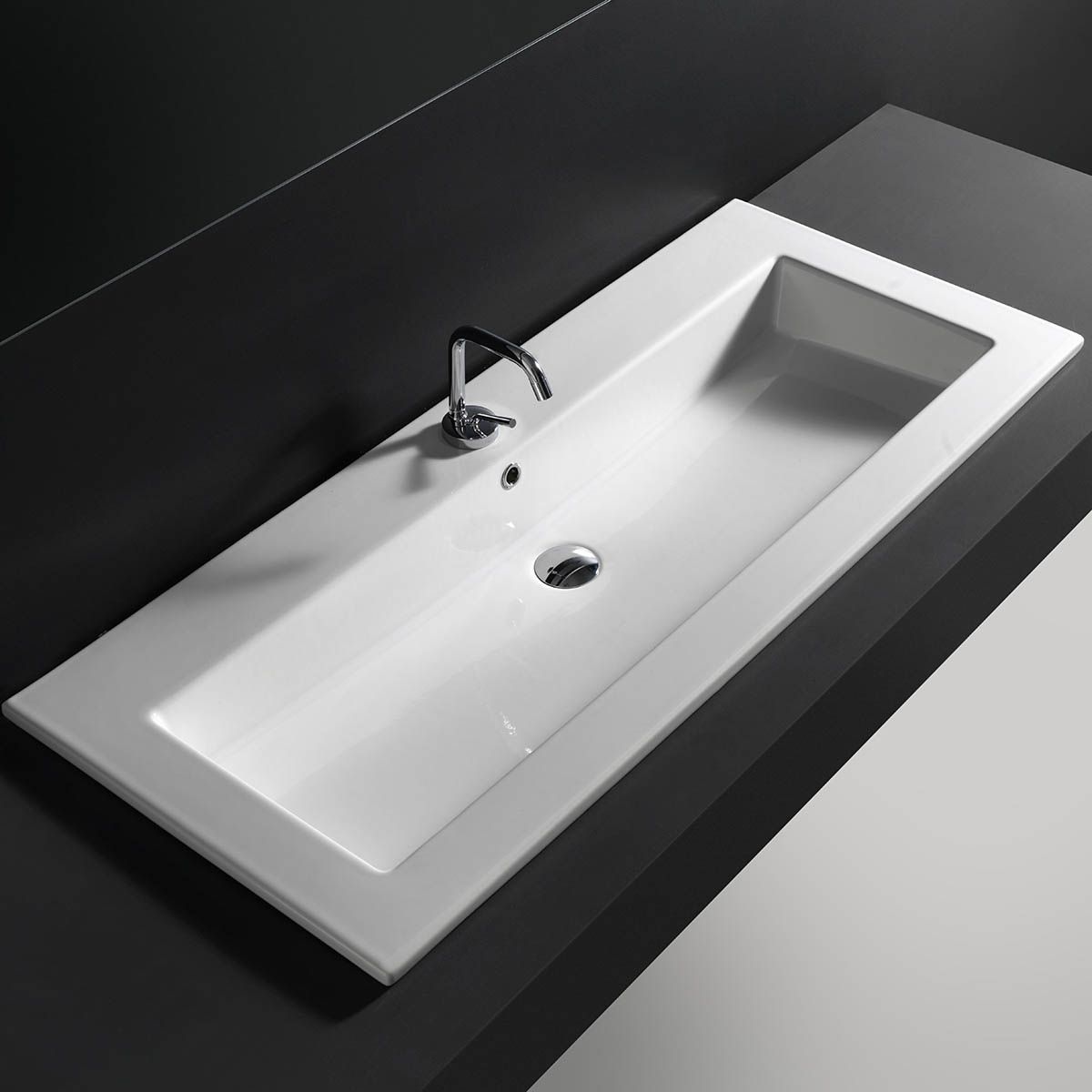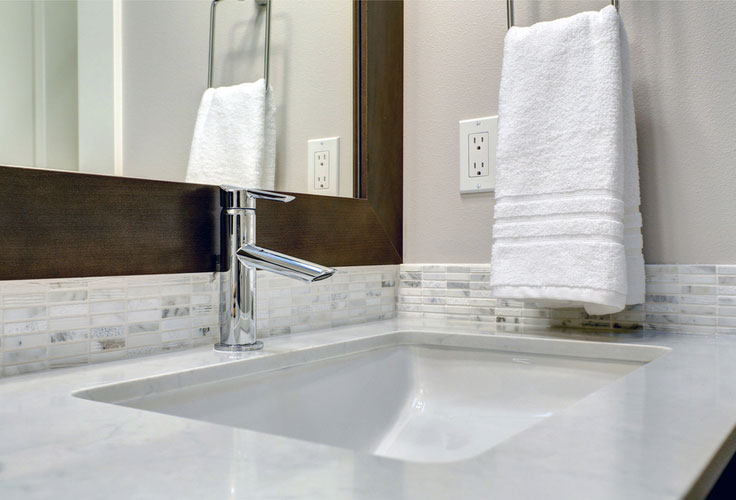A self-rimming sink, also known as a drop-in sink, features a rim or lip that rests on the countertop. This design allows for easy installation from above the counter.
Self-rimming sinks offer a popular choice for kitchen and bathroom installations due to their straightforward mounting and versatile style compatibility. Crafted to provide an efficient solution for renovators and builders, these sinks integrate seamlessly with a wide range of countertop materials, from laminate to solid surface options.
Their rim, which supports the sink’s weight, ensures a stable fit and helps prevent water from seeping underneath. With a variety of materials, sizes, and finishes available, self-rimming sinks cater to both aesthetic preferences and functional requirements. Durable and cost-effective, they are an excellent option for those seeking a quick and simple upgrade to their space.

Credit: www.homedepot.com
Introduction To Self-rimming Sinks
Imagine a sink that sits gracefully atop your counter, creating a sleek appearance with minimal fuss. This is the essence of a self-rimming sink. Unlike undermount or vessel types, self-rimming sinks, also known as drop-in sinks, blend convenience with style. Let’s delve into the world of self-rimming sinks and discover what sets them apart from their counterparts.
The Basics Of Sink Design
Sink design is essential in shaping kitchen or bathroom functionality and aesthetics. From depth to material and mounting style, each element is crucial. Self-rimming sinks have distinct design features. They are designed to drop into a pre-cut hole in the countertop. With their distinct edges, they rest on top of the counter with a visible lip.
Unique Features Of Self-rimming Options
Self-rimming sinks stand out for their unique features. They offer a hassle-free installation process; no need for complex under-counter support. They typically include a wide rim that not only adds to their stability but also catches any spills, keeping the countertop dry. This makes them a preferred choice for many homeowners. Additionally, these sinks come in a variety of materials and finishes, allowing custom solutions for different decor styles.
- Easy Installation: DIY-friendly, saving you time and money on installation.
- Versatile Design Choices: Comes in varied materials like stainless steel, porcelain, and composite.
- Functional Edge: The raised edge acts as a barrier against water spillage.

Credit: www.modobath.com
Installation And Compatibility
Installing a self-rimming sink is a project many DIY enthusiasts can tackle. This type of sink, also known as a drop-in sink, fits over a hole on your countertop. Its rim supports it from above, making it compatible with many countertop materials. You’ll find it aligns perfectly with your kitchen or bathroom design, offering a sleek look without complex installation steps.
Ease Of Mounting On Various Countertops
The self-rimming sink is a top choice for diverse countertop materials. Its design allows effortless mounting onto granite, laminate, wood, and even tile surfaces. The significant advantage is the sink’s lip, which sits on the countertop, eliminating the need for under-counter support.
Compatible countertop materials include:
- Granite
- Laminate
- Wood
- Tile
Required Tools And Steps For Diy Installation
For DIY installation, gather these tools to ensure a smooth process: Jigsaw, Tape Measure, Drill, and Screwdriver.
Follow these steps:
- Measure the sink and countertop.
- Mark the cutout area on the countertop.
- Drill a pilot hole inside the marked area.
- Use a jigsaw to cut out the hole.
- Place the sink into the hole, ensuring a snug fit.
- Seal the edges with silicone to prevent leaks.
- Attach the sink to the plumbing.
- Check all connections for leaks.
Benefits Of Choosing Self-rimming Sinks
Exploring the world of kitchen renovations unveils a variety of sink options. Among these, self-rimming sinks stand out for their convenience and style. Discover the advantages that make them a smart choice for any kitchen transformation.
Aesthetic Appeal And Diversity
Self-rimming sinks blend seamlessly with any countertop material, adding an undeniable charm to your kitchen space. These sinks come in a vast array of materials, such as stainless steel, porcelain, and composite. They cater to both modern and traditional designs, thus meeting diverse aesthetic preferences. The rim of these sinks provides a smooth transition from sink to surface, contributing to a cohesive and polished look.
- Variety of shapes: From classic round to sleek square.
- Finish options: Glossy, matte, or brushed to suit your decor.
- Color selections: Match or contrast with countertops.
Maintenance And Cleaning Advantages
Self-rimming sinks offer practical benefits in maintenance and cleaning. The unique design of the rim prevents water from spilling onto the countertop, safeguarding against water damage. The installation creates a natural seal, reducing the risk of dirt and grime buildup.
| Ease of Cleaning | Installation Benefits |
|---|---|
| Wipe the rim easily with no hard-to-reach corners. | Drop-in design allows for quick and simple installation. |
| No need for special cleaning agents. | Compatible with various countertop materials. |
Cleaning these sinks is a breeze. Use a soft cloth and mild detergent to maintain their shine and hygiene. For those who value time and simplicity in upkeep, self-rimming sinks are a fitting choice.

Credit: www.faucetdepot.com
Potential Drawbacks To Consider
While self-rimming sinks offer convenience and style, it’s vital to weigh some potential drawbacks before making your selection. These downsides can impact the overall aesthetic and functionality of your kitchen or bathroom space. Let’s explore the key points to consider.
Limitations In Countertop Materials
Not all countertop materials work well with self-rimming sinks. Here’s what to watch out for:
- Thickness: Thin countertops may not support the sink properly.
- Material: Some materials, like laminate, can warp over time due to moisture.
- Durability: Stone or solid surfaces offer better support and longevity.
Challenges With Seamless Integration
Sinks that sit on top of the counter can disrupt the smooth lines of your space. Consider these points:
| Challenge | Explanation |
|---|---|
| Cleaning: | Debris can get caught around the edges, requiring extra attention. |
| Appearance: | The rim may stand out against the countertop, affecting your design vision. |
Comparison With Other Sink Types
Choosing the right type of sink is crucial for your kitchen’s functionality and style. Self-rimming sinks have their edges rest on top of the countertop. They make installation a breeze. Still, how do they stack up against other sink styles? Let’s compare them with undermount and vessel types to see which suits your home best.
Self-rimming Vs. Undermount Sinks
Self-rimming sinks sit on top of the counter. Their rim holds them in place. This design offers several benefits:
- Easy to Install: Drop it in the hole and seal it.
- Compatibility: Works with most countertop materials.
- Cost-Effective: Generally, less expensive to install.
On the flip side, undermount sinks attach beneath the countertop. This arrangement provides a different set of advantages:
- Sleek Look: Offers a smooth countertop transition.
- Easy Cleaning: Wipe debris straight into the basin with no lip to catch crumbs.
- More Counter Space: Takes up less room on top of the counter.
Self-rimming Vs. Vessel Sinks
Comparing self-rimming sinks to vessel sinks shows a clear style difference. Vessel sinks sit on top of the counter like a bowl. Here’s a quick look at their features:
| Feature | Self-Rimming Sink | Vessel Sink |
|---|---|---|
| Installation | Easier, just a hole needed | More complex, requires precise placement |
| Height | Flush with the counter | Raised, can be more ergonomic |
| Style | Classic and versatile | Modern and striking |
Frequently Asked Questions For What Is A Self Rimming Sink
What Defines A Self-rimming Sink?
A self-rimming sink, also known as a drop-in, has a visible lip that rests on top of the counter for support and stability.
Can Self-rimming Sinks Fit Any Countertop?
Self-rimming sinks are versatile, fitting most countertop materials provided the cut-out dimensions align with the sink’s rim.
How Do You Install A Self-rimming Sink?
Installation involves placing the sink in a pre-cut hole in the countertop and sealing it to prevent water leakage.
What Are The Pros Of Self-rimming Sinks?
Self-rimming sinks are easy to install, affordable, and available in a variety of materials, styles, and colors.
How To Maintain A Self-rimming Sink?
Maintain a self-rimming sink by regularly cleaning the rim and sealant to prevent grime build-up and ensuring a snug, leak-free fit.
Conclusion
Understanding self-rimming sinks is essential for any kitchen or bathroom design. They offer ease of installation and a sleek finish, suitable for diverse aesthetics. As you contemplate the choices for your next renovation, remember the practicality and style of a self-rimming sink.
Perfect for giving your space a contemporary edge while ensuring functionality.




Leave a Reply